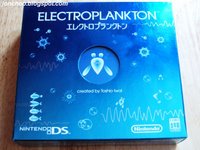
Electroplankton (Japanese version)
I can already hear the collective sigh of "there he goes again with his game reviews". Ah, but this isn't a review of a game. Just because it is only playable on a portable game console does not make it a game. Plus this isn't just any review. It's a 'Mega Review', complete with videos too.
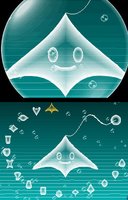 Electroplankton was created by fame Japanese media artist Toshio Iwai* (who also created SimTunes for the PC). While the gaming community found it hard to describe the 'game' and pigeon'ed holed it into the sub-genre 'mini-games', Electroplankton is best described as an interactive musical media and should be reviewed with the clear knowledge that it isn't a game. There are no goals to complete and no game overs to frown upon. The perfect title to rub it into your anti-games mates.
Electroplankton was created by fame Japanese media artist Toshio Iwai* (who also created SimTunes for the PC). While the gaming community found it hard to describe the 'game' and pigeon'ed holed it into the sub-genre 'mini-games', Electroplankton is best described as an interactive musical media and should be reviewed with the clear knowledge that it isn't a game. There are no goals to complete and no game overs to frown upon. The perfect title to rub it into your anti-games mates.* See his precursor to Electroplankton here
It can also be considered a work of art, at least in my opinion. This title was part of the first wave of 'touch-generation' non-games that Nintendo released last year (along with Brain Training*, Animal Crossing: Wild World and Nintendogs - such touch-generation non-game games opened a previously untapped market and helped Nintendo conquer the Japanese console market).
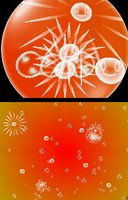 Electroplankton is made up of ten tracks (or mini-games as gaming presses call them) where you are to manipulate the planktons with your stylus, which in return will create music for your pleasure. It is a musical instrument of art. And like all musical instruments your ability to manipulate the instruments will either reward or dishearten you. However, unlike any old musical instruments, Electroplankton automatically rewards you with the sight of up most beauty of post-modernism abstract art.
Electroplankton is made up of ten tracks (or mini-games as gaming presses call them) where you are to manipulate the planktons with your stylus, which in return will create music for your pleasure. It is a musical instrument of art. And like all musical instruments your ability to manipulate the instruments will either reward or dishearten you. However, unlike any old musical instruments, Electroplankton automatically rewards you with the sight of up most beauty of post-modernism abstract art.Upon starting Electroplankton you will be presented with two modes of play - Performance Mode and Audience Mode. The boot screen also allows you to optimise the sound through the DS's already good stereo speakers or through a headphone.
Audience Mode is a demo version of the game where the CPU controls the planktons. Each tracks plays for a few minutes in cycles just like an audio CD. You can override the CPU and take control (although it won't override the time). It is a nice mode to see what each tracks has to offer or when you just want to relax and watch/listen rather than compose your own music. Hook it up via to a Hi-Fi via line-in and enjoy. Unfortunately you can't close the DS lid and leave the music on like a walkman though I do wish I could hook the DS to a telly and watch the planktons swim around on a 30" screen. That would have beaten any iteration of WinAMP visualisation plug-ins.
Performance Mode is where the composing comes into play. With ten different kind of planktons/tracks/music composition tools/mini-games/whatever to play with you will be hard pressed to find something you will like. The following are the English title to each program and a short description on what each does:
01 Tracy
The first of the ten tracks, Tracy features six different coloured planktons where you drag each of her, creating a path for them to follow. Each planktons will make its own unique sound of each plankton sounds and their tempo changes depending on the speed and direction of the path you created.
02 Hanebow
A leaf shoots out planktons (that looks like tadpoles) towards a plant (selectable) where they will bounce off each of the leaves until it falls back into the water. You can change the trajectory of the cannon as well as the frequency in which it spurts out planktons. Each bounce creates a tune. By altering the angles of each leaves you can create a nice rhythm of bounding planktons. This is the only 'game' where you can assign a goal (e.g. to keep as many planktons out of water, getting the leaves to turn red, getting the flower to pop up) if you wish.
03 Luminaria
There are four planktons on each corner. Surrounding them are pre-determined paths set by arrows. Tapping on each plankton will move them, each having different speed - therefore producing different pitches and sound. The red one for example sounds like a piano. Each one of the arrows will emit a different note as the planktons crosses them. By changing the direction of each one of the arrows you can compose a nice little chill-out song. If you are lazy you can use the d-pad to reset the arrows. It's easy and surprisingly engrossing to the point that you won't have to keep those Café Del Mar CDs anymore. This is my favourite 'track' of Electroplankton.
04 Sun-Animalcule
This is a very unique musical composition tool. You use the stylus to seed as many or as little planktons as you want. As the title indicates, the plankton(s) relates to the sun. It also changes depending on its size and time (night or day). The position of where the planktons were laid also determines the kind of sound each plankton produces.
05 Rec-Rec
You don't get much control on any of these fishes in this track. There are four fish that swims from left to right and the music is very upbeat. Tapping on each of the planktons will allow you to record from the microphone your voice (or the house dog). With each recorded sound then being played back by each of the planktons, you will find yourself with a nice little track of upbeat tempo.
06 Nanocarp
Ripples, produced by the tapping of the screen, when arrives at each plankton will cause them to produce a unique sound. I think there are around 20 swimming around. You can line them up by blowing at the screen (or clapping) but they won't stay put. Depending on the sound you make the Nanocarps will line up differently on the screen. The whole point is to create ripples passing through layers of plankton, producing sounds based on chain reaction. You can also create ripples using the d-pad. It's like a calming version of wind chimes and could easily be one of your favourite.
07 Lumiloop
You spin five planktons (which are shaped like records) around using the stylus, each creating a ray of sound (and colour). Depending on the direction, the rotation speed etc. the sound created with the five planktons can be quite engrossing.
08 Marine-Snow
As the title indicated, the planktons are in the shape of snow flakes (hence the title). Tapping each of the planktons will create a unique sound. No matter where each plankton is located (they move around in a chaotic Bejeweled-like manner), they will always produce a unique sound, so it can get confusing if you attempt to use them as composing tool. But this is the composition tool you will have most control of - if you can remember which snow plankton produces which sound!
09 Beatnes
This could be the favourite of Nintendo retro fans. These five dancing planktons plays a collection of classic and retro Nintendo tracks, each with unique and well-loved 8-bit Nintendo beeps (e.g. Mario collecting coins) which you can hear by tapping on each of the different planktons. Tapping the keys on their body will produce notes, like a piano.
10 Volvoice
The final track also happens to be my least favourite. You record your voice (say maybe speaking your name) and each Planktons alters your voice. It is fun, but is very limited.
Below is a five minutes video compilation of few of the tracks (Luminaria, Hanenbow, Beatnes, Lumiloop, Sun-Animalcule and Tracy). It should give you an overall idea to what Electroplankton is. Note that the graphical and audio quality of Electroplankton is much better than the video capture below.
The sounds created are beautiful, even over the DS's small stereo speakers. However to enjoy the music fully you will need a good set of earphones. The sounds are detailed and rich to the point of you can hear the Planktons swimming around and bubbles forming. I myself like to experiment with the sounds created just before I go to bed, especially after a stressful day.
The graphics, while simple and not earth shattering, is nice and calming. Everything is brightly coloured and the saturation is over the top, all in a happy way. Even the planktons seem loveable.
The only problem with the game is you are unable to save the music that you created, although you may argue that no musical instrument comes with a save button. Does your guitar or piano come with one? Nope. Like those you need to hook up Electroplankton to a recording deck that has a line-in socket. Most portable DAPs has line-in sockets anyway so composing your next Grammy has never been easier if you are savvy at figuring out which wires goes where.
 The Japanese version is quite unique as it is the only DS game not to feature the massive white DS logo on the case. It also comes in a nice blue card box (like some special edition music CDs) and a free blue earphone. The earphone is a cheapo version though but it is still a nice bonus.
The Japanese version is quite unique as it is the only DS game not to feature the massive white DS logo on the case. It also comes in a nice blue card box (like some special edition music CDs) and a free blue earphone. The earphone is a cheapo version though but it is still a nice bonus.Because the Electroplankton requires no literacy level, the Japanese version is import friendly. The only thing you will miss out is the descriptions of each plankton. The manual is also in Japanese and is thick. It is filled with useful tid-bits (that I couldn't read), drawings (presumably by Toshio Iwai himself) and handwritten notes. This basically puts all game manuals AND CD inserts to shame. It is unlikely such detailed manual would be reproduced for the EU version. On a slight note, you can also import the North American version if English is VERY important to you.
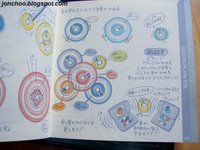 Electroplankton was slated for a UK release of April 2006 but has since been pushed back to June (I believe). That was what GAME told me anyway, but I believe you can purchase it from Nintendo's online store. I don't blame them as I doubt UK gamers, many who traditionally scoff at unique titles, will get this. Hell, even Guitar Hero bombed here. NoE shouldn't be blamed for not bothering to market this an effectively sceptic market as even NoA didn't bother to ship this title to brick and morter stores.
Electroplankton was slated for a UK release of April 2006 but has since been pushed back to June (I believe). That was what GAME told me anyway, but I believe you can purchase it from Nintendo's online store. I don't blame them as I doubt UK gamers, many who traditionally scoff at unique titles, will get this. Hell, even Guitar Hero bombed here. NoE shouldn't be blamed for not bothering to market this an effectively sceptic market as even NoA didn't bother to ship this title to brick and morter stores.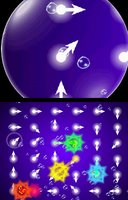 But don't let that dishearten you. You may or may not like Electroplankton. In fact some of you may hate it. If all you want is mind blowing 'realistic' graphics and gunning down call girls then this is the wrong game for you (and I pity you). Myself I find it an utterly wonderful experience. And no, this won't be the last non-game game that would be released on the DS platform. Already we are seeing more and more music based games like the mind blowing Osu! Tatake! Ouendan! and Daigasso! Band Brothers.
But don't let that dishearten you. You may or may not like Electroplankton. In fact some of you may hate it. If all you want is mind blowing 'realistic' graphics and gunning down call girls then this is the wrong game for you (and I pity you). Myself I find it an utterly wonderful experience. And no, this won't be the last non-game game that would be released on the DS platform. Already we are seeing more and more music based games like the mind blowing Osu! Tatake! Ouendan! and Daigasso! Band Brothers.Personally this is one of my favourite 'game' to play at night just before bed whenever I want to kick down and forget the day.
7/10
Note: This review was written during Easter and I have only now decided to publish it (after forgetting about it). Sorry.
* Tokoku Daigaku Mirai Kagaku Gijutsu Kyoudou Kenkyu Senta Kawashima Rutu-kyouju Kanshuu: nou wo Kitaeru Otona no DS Toreningu (Professor Ryutu Kawashima of Tokoko University's Centre for Collaborative Research on Future Technology Presents: Train Your Brain - DS Training for Adults)

8 comments:
yes
Yeah!!! I love Japanese technique.
Who doesn't love Japanese and their techniques. They are the best.
Knew technology comes and goes...is just people don't undersdant them so well.
London escorts.
Post a Comment